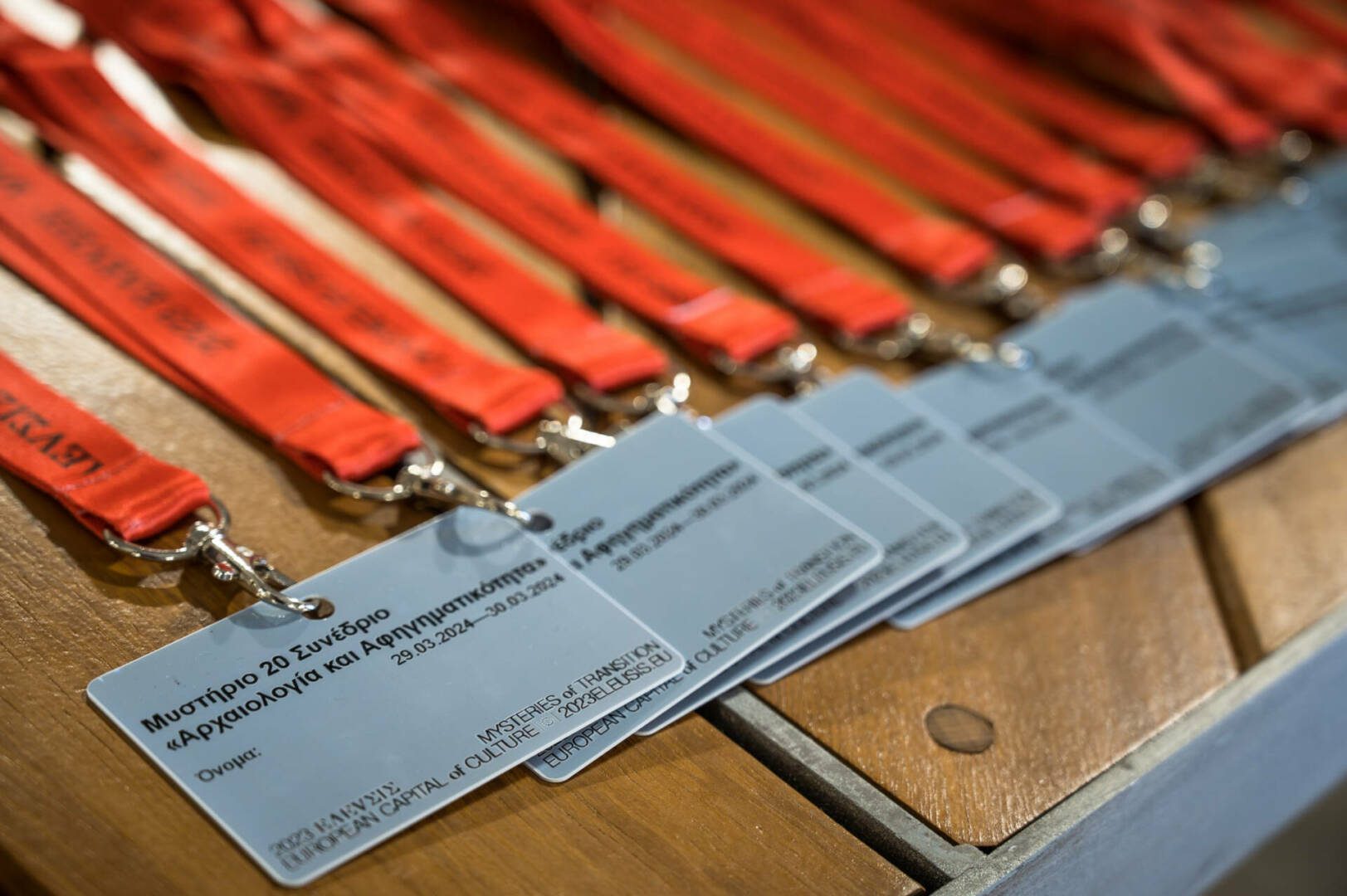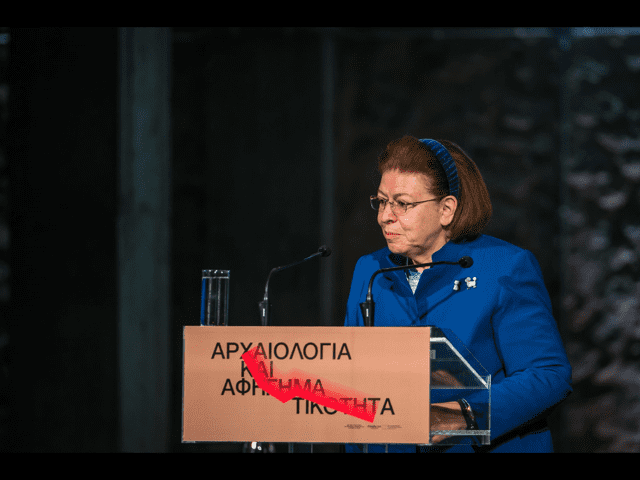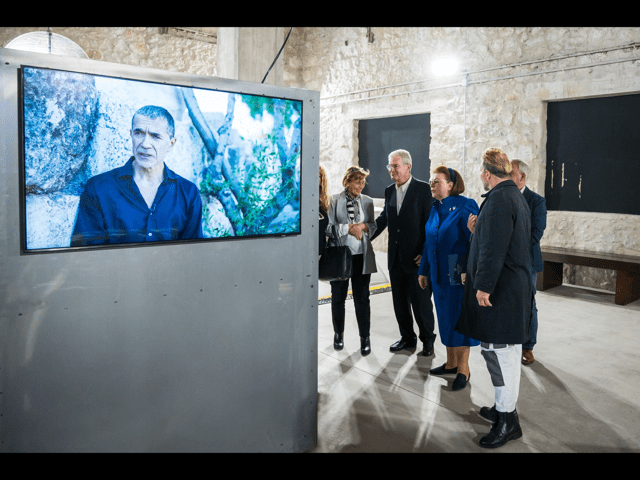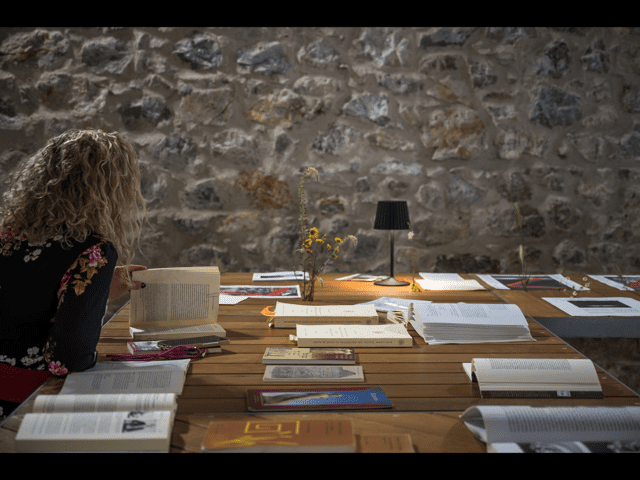Mr. Mayor,
Mr. President of the ECOC Society,
Dear Nana Spyropoulou,
Dear Michail Marmarinos,
Dear colleagues and friends,
I am so delighted to be here in this space here today. Five years ago, I – and I think none of you – could not have imagined how it could transform and evolve. Our presence here today is the outcome of a collective effort, where everyone has done their part.
In June 2019, Kyriakos Mitsotakis, during his election campaign, committed to the people of Elefsina that a new archaeological museum would be built on the site of the Old Oil Mill Factory, which would house the antiquities of Elefsina of the archaeological site, which are of immense importance, but also of the wider region. This was one of the first priorities we set in our programming when, in July 2019, the Greek people entrusted Kyriakos Mitsotakis with the governance of the country. The Ministry of Culture, following all the necessary steps with the support of the Municipality – as there were issues which had to be resolved at a local level – acquired the Old Oil Mill Factory from the National Bank.
Mr Mayor, Mr President, I continue to believe that the European Capital of Culture was and is a great opportunity for the city. And with this acquisition, as you said so yourself, Elefsina has been redefined in the cultural charter and beyond. This acquisition must be preserved, as must the infrastructure which was created, such as Cine Eleusis, which was restored thanks to the kind support of Hellenic Petroleum, and which must be now maintained and exploited to the maximum.
Why am I talking specifically today about sponsorships? Because I want to reinforce what you mentioned, when we were all together, that so many things have happened. In 2019, there was absolutely nothing for the Capital of Culture. We all met during the Interministerial Committee, which was formed after the decision of Prime Minister Kyriakos Mitsotakis, the Region, the Municipality and the central government, the local community, the company of the Capital of Culture, we joined forces and achieved the current outcome. So, let us consider this as the beginning of the “next day” for Elefsina.
As most of you here may very well know, the Ministry of Culture is currently making the largest cultural investment, which has ever happened in the country. We are implementing more than 830 projects with a total budget exceeding €1.2 billion, with an equal and balanced treatment of cultural heritage and contemporary culture as much as possible. These projects cover the whole spectrum: entrepreneurship, innovation, digitisation, traditional restoration and enhancement of monuments and archaeological sites, upgrading and organisation of arts education, support for contemporary artistic creation and traditional craft production, implementation of accessibility projects and participation of all citizens in cultural activities and processes.
The projects have a targeted distribution with a regional focus and a development perspective. They focus on the creation of new and the strengthening of existing major cultural infrastructures and institutions – formal and local – of traditional and contemporary culture in specific areas, in order to act as poles of attraction for multifaceted development activities. They promote economies of scale, synergies, complementarity and multiplier effects in the promotion, visibility and exploitation of the entire tangible and intangible cultural heritage of wider regions. Our aim is to reorganise, decentralise, disperse and redistribute the touristic flow -and Elefsina can benefit greatly from this-, and to promote a more uniform, balanced and sustainable local and regional economic development, through the promotion of the culture-tourism relationship, the strengthening of cultural tourism, the creation of new and the strengthening of existing attractions, the increase and improvement of services and, ultimately, the development of an ‘experience economy’.
In order to achieve these objectives, the need and the challenge for a complete change of paradigm in the field of cultural management policy has been clear from the outset. That is, from the inherited old, static, one-dimensional and therefore ineffective model we have moved on to a new, flexible, dynamic and adaptable one. Seeking precisely to bring about a broad development reform in the field of Culture, over the last four years we have established the “Cultural Charter for Development and Prosperity” for each of the 13 Regions of the country, a road map for the development of Culture as a strategic development resource and as an important factor of social cohesion and prosperity. The Cultural Charter, which is constantly being refined and developed, is already showing significant benefits for the economy and society. The key principles of the development strategy and policy in the cultural sector can be summarised as following:
– Ensuring the conditions, financial and organisational, as well as the creation, maintenance and continuous improvement of the infrastructure and services related to the protection, conservation, promotion, display, accessibility and experience of cultural heritage by the general public, in all its aspects and manifestations, material and immaterial, with maximum use of modern technologies to improve usability, functionality and efficiency.
– Supporting and strengthening contemporary artistic creation and the creative industry by implementing structural reforms that provide answers to decades-old outstanding problems.
– Designing and implementing synergies and partnerships for the combined exploitation of cultural heritage and contemporary creativity, with multiplier effects in achieving smart, sustainable and inclusive development at local, regional and inter-regional level.
The enrichment, revitalisation and combined utilization of cultural heritage capital with elements of contemporary cultural and artistic creation is a central and extremely important aspect of this effort, which aims to promote and exploit the country’s entire cultural heritage through the connection of it with present time, everyday life and people’s needs.
In this regard, a very characteristic and already very successful example of a combined utilization of cultural heritage and contemporary creation is the well-known institution “All of Greece One Culture”, which was launched during the pandemic in 2020 and has by now been established by gaining the interest and acceptance of the audience. This year, for the fifth consecutive year, this institution offers new and high quality productions; 70 new productions have been created within the framework of the institution, and will be presented in archaeological sites and museums of the region. We have decided to exclude Attica due to the fact that there are already many projects happening in Attica, giving the opportunity to artists and artistic groups to create and present works within specific thematic axes, creating employment opportunities for a significant number of professionals in the cultural sector. A central element of the institution’s philosophy is the meeting and synergy of many art forms, out of which new, innovative and hybrid artistic forms and means of expression are born, interact harmoniously with elements of the cultural heritage of each place.
As old and close associates, most of you are well aware that all these elements, which today constitute the official policy of the Ministry of Culture, are documented and supported by a wealth of publications of modern scientific research, as well as by a series of studies which have been carried out in recent years either by the Ministry of Culture or by independent bodies. We have examined and analysed all of these in the past, both in fora similar to the present one and in private discussions with many of you. In one of these discussions with dear Michail Marmarinos, preliminary thoughts and ideas were formulated, incorporated to a certain extent and applied in the artistic programme of 2023 Eleusis European Capital of Culture.
A central parameter of the high level artistic and wider cultural programme of 2023 Eleusis entitled MYSTERIES OF TRANSITION, which was envisioned and curated with inspiration, dedication and efficiency by the Artistic Director of the European Capital of Culture Michail Marmarinos and an important factor of its success was precisely the fruitful, creative and “mysterious” meeting and coupling of the ancient and more recent past with the present, the emergence of timelessness, continuity and transition in space and time. In this case, the entire landscape of Thriassio, as well as individual sites and monuments of cultural heritage have been both sources of inspiration and fields for the implementation of artistic projects, events and interventions, for which they have not only served as reception areas or backdrops, but have developed an essential, and here is the success, dialogical relationship with them on a physical and conceptual level, narrative and symbolic. I do not want to translate or interpret Michail Marmarinos, I am saying what I understood and what I experienced through the MYSTERIES OF TRANSITION.
The conscious encounter of antiquity and contemporary creation, archaeology and art, in places with a great special historical and cultural weight, but also an intense emotional load, was at the centre of many projects of the Capital of Culture programme. A prime example is the archaeological site of the Telestirion, where the events and rituals of the famous Eleusinian Mysteries took place, which was the focus of Mystery 20 Performing Arts Initiator – Narrative Archaeology. This particular project occupies a key position in Michail Marmarinos’ programme, seeking to become part of the long-term legacy of the organization and to serve as a broader model for redefining the relationship between the archaeological site and the visitor through the contribution of the performing arts. The aim is to upgrade the narrative of archaeological information by enriching it with additional cognitive and sensory elements, which make it possible to deepen, interact and decipher not only the visible but also the unseen aspects of the site and its history, making the visit a universal experiential experience, a kind of “initiation”.
Mystery 20 Performing Arts Initiator – Narrative Archaeology, which is implemented in the framework of the National Recovery and Resilience Plan Greece 2.0 with the support of the Ephorate of Antiquities of West Attica, has a dual, performative/artistic and research orientation, with the elements of scientific research and practical-experimental application in the form of presentations and performances being interconnected. In approximately two years of the programme’s implementation, it has provided a fruitful field of encounter and collaboration for numerous researchers and artists from a multitude fields, including Archaeology, Architecture, Film, Dance, Theatre, Music and Psychology, and as a result will deliver to the public more than 50 presentations.
The research orientation of this project includes the conference “Narrative Archaeology – Performance in Archaeological Sites and Excavation of Human Experience”, which focuses on the interdisciplinary development of standard methodology and the consolidation and promotion of good practices in the application of the performing arts in our archaeological sites and monuments, based on internationally accepted principles of cultural management and monument policy governed by the existing institutional framework.
In concluding this intervention, I would like to express my heartfelt thanks and congratulations to Michail Marmarinos and his colleagues for the conception and organization of Mystery 20. But mostly, I would like to express my gratitude for his extremely important and successful contribution to the organization and implementation of 2023 Eleusis European Capital of Culture through the high quality artistic programme. I would also like to thank Nana Spyropoulou and mention the great absentee Despina Geroulanou. If it were not for these people, despite the support of the municipal authority, despite the support of the Region, and the material and moral support of the Greek Government and the Ministry of Culture, we would not have the result we have achieved and of which we are proud. Finally, I would like to thank all of you who are here today, giving your testimony of your own experience in this particular Mystery and in this particular conference.
Thank you very much.
* The 2023 Eleusis conference NARRATIVE ARCHAEOLOGY | “Performance in archaeological sites and excavation of human experience” took place for the first time on this theme, on March 29 and 30, at the Old Olive Mill of Elefsina, in the context of the interdiciplinary art project 20 Performing Arts Initiator – Narrative Archaeology. The main objective of the two-day conference was to expand and explore the interdisciplinary dialogue between the fields of Arts and Archaeology.



